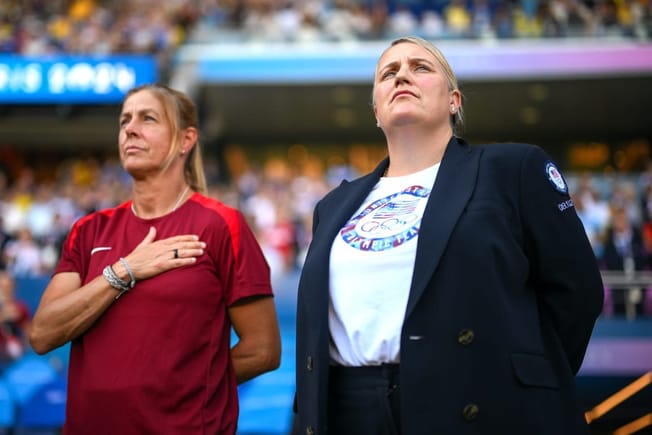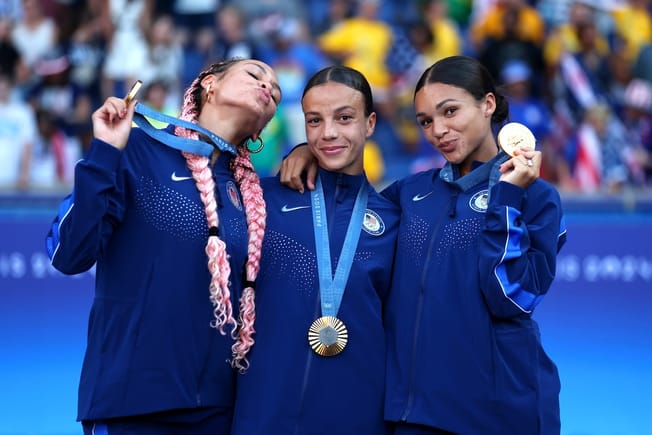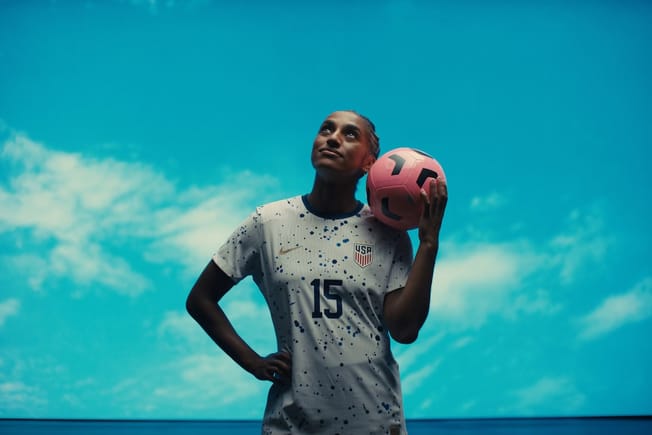There’s a lot going on with the United States women’s national team right now.
World Cup and Olympic qualification via the Concacaf W Championship kicks off next week. The team also just played a pair of friendlies against Colombia. Then there’s this generational shift that’s happening right in front of our eyes. A group of younger players is breaking into the team in every line – the defense, the midfield, and the attack – and a number of familiar names aren’t with the team.
“I think it’s a very fresh energy,” USWNT winger Sophia Smith, 21, told Backheeled earlier this week. “People are very, very excited to be in camp and to be able to represent the country and just get to play with each other.”
To get a better idea of who will be on the field for the U.S. in qualifying and to better understand how these players actually play, we’re building a USWNT depth chart.
Now, roll the disclaimer: this depth chart isn’t gospel, nor does it feature every player in the U.S. pool. We’re just focusing on the players that Andonovski called up to this current roster. Catarina Macario, Lynn Williams, Sam Mewis, Abby Dahlkemper, and Tierna Davidson are all out injured, as is Christen Press, although she was apparently going to be left off of this roster even before her knee injury. There’s also Crystal Dunn, who just had a baby, Julie Ertz, who is pregnant, and Tobin Heath, who hasn’t played a game since April.
With that out of the way, let’s get to it. We’re arranging this team in a 4-3-3 shape, because that’s what the United States uses on a regular basis.
GOALKEEPER:
- Alyssa Naeher (Chicago Red Stars)
- Casey Murphy (North Carolina Courage)
- Aubrey Kingsbury (Washington Spirit)
Alyssa Naeher is the clear number one goalkeeper in the pool right now. She’s the most experienced goalkeeper on the U.S.’s roster and even though some of her shot-stopping numbers are mediocre at best this year, expect Naeher to start at the W Championship. Murphy and Kingsbury will fill in the other two spots.
CENTER BACK:
- Becky Sauerbrunn (Portland Thorns)
- Alana Cook (OL Reign)
- Naomi Girma (San Diego Wave)
- Emily Sonnett (Washington Spirit)
I’m pretty sure that Becky Sauerbrunn is going to live forever. Right now, she’s sitting at more than 200 caps and is still the first center back on Andonovski’s team sheet for every big game. After Sauerbrunn, Alana Cook is the most experienced central defender in the squad. Cook isn’t an exceptional passer, but she adds value defensively and can contribute in the air as well.
Jaelin Howell's first career international goal is a nice finish. Another knock-down-header assist for Alana Cook. 7-0 #USWNT pic.twitter.com/W30H7KSR2Z
— Jeff Kassouf (@JeffKassouf) April 9, 2022
Naomi Girma is extremely new to the national team and is in the middle of her first-ever season of professional soccer, playing regular minutes for the San Diego Wave in the NWSL. Girma is still developing, but she has some quality on the ball and can keep up defensively.
Finally, Sonnett: she’s a defensive utility player for the USWNT. She’s played some at center back, right back, and left back in her U.S. career.
RIGHT BACK:
- Kelley O’Hara (Washington Spirit)
- Sofia Huerta (OL Reign)
- Emily Sonnett (Washington Spirit)
Kelley O’Hara has been and will continue to be the U.S.’s primary right back. She’s comfortable in different vertical channels and she adds value with her passing from deeper areas, which is useful for such an attack-heavy team.
One quick note on how Andonovski uses his fullbacks (and especially his right back): he doesn’t ask them to overlap like crazy and get to the end-line all the time. Instead, the fullbacks often stay back, almost in line with the No. 6 or the No. 8s. The idea is to let the wingers stay high and truly dictate the United States’ attacking play while the fullbacks provide offensive support and defensive protection.
Like O’Hara, Huerta fits that same deep right back profile. She’ll pinch into the right halfspace and she loves to hit an early cross into the box. Huerta can also, occasionally, do things like this:
SOFIA HUERTA 🚀
— Attacking Third (@AttackingThird) March 19, 2022
What a strike 💫 pic.twitter.com/GtttL5GuG5
And then, as always, there’s Sonnett rounding out this position group.
LEFT BACK:
- Emily Fox (Racing Louisville)
- Kelley O’Hara (Washington Spirit)
- Emily Sonnett (Washington Spirit)
With Crystal Dunn recently giving birth, Emily Fox has started every game but one the U.S. in 2022. Fox has good recovery speed and she gets forward more on the left side than any of her defensive teammates do over on the right.
After Fox, O’Hara has played a chunk of minutes at left back this year. And, oh hey, look, there’s Sonnett.
CENTRAL DEFENSIVE MIDFIELD:
- Andi Sullivan (Washington Spirit)
- Lindsey Horan (Olympique Lyon)
- Kristie Mewis (NJ/NY Gotham)
In Julie Ertz’s absence, Andi Sullivan has become the starting No. 6 for the USWNT. Sullivan isn’t flashy, but she’s been an above average player in every category of American Soccer Analysis’ goals added metric while playing for the Washington Spirit this year in the Challenge Cup and the regular season.
There aren’t any other true defensive midfielders in the squad after Sullivan, but it looks like Lindsey Horan and Kristie Mewis are Andonovski’s choices to deputize at that spot. Mewis is mobile, she can clean up plays in the middle, and progress the ball. More on Horan in a minute.
CENTRAL MIDFIELD:
- Rose Lavelle (OL Reign)
- Lindsey Horan (Olympique Lyon)
- Ashley Sanchez (Washington Spirit)
- Kristie Mewis (NJ/NY Gotham)
- Taylor Kornieck (San Diego Wave)
Rose Lavelle and Lindsey Horan have been around the USWNT for quite some time now – and they’re both still key players for this U.S. team. Lavelle’s sauce levels are off the charts and she counter presses aggressively for both club and country. Here’s a short analysis video that I put together on Lavelle a while back that still rings true today:
Rose Lavelle is magic. She’s shown it with the @USWNT and right now she’s showing it with the @WashSpirit. I analyzed Lavelle, one the most creative and effective midfielders that the United States has ever produced, here:
— Joseph Lowery (@joeclowery) July 3, 2020
(Volume ⬆️) pic.twitter.com/BUnhJMH6Zs
Horan, coming off of a Champions League win with Lyon, doesn’t have Lavelle’s ability to beat defenders one-v-one, but she’s an asset with her distribution and her off-ball movement.
Outside of Horan and Lavelle, Ashley Sanchez is probably the player who is pushing the hardest for minutes in one of the No. 8 spots. Like Lavelle, Sanchez has phenomenal close control and regularly creates chances in the attack. Per ASA, she’s fourth in the NWSL among midfielders in xG+xA in the regular season. You can see some of her creativity in this compilation from her time on the field against Colombia over the weekend.
ashley sanchez vs. colombia (6/25/22) #OneSpirit pic.twitter.com/shDv4RSENb
— Noah🇪🇷 (@PositionaIPIay) June 27, 2022
The other two No. 8s on the depth chart have different profiles than Sanchez. Mewis, when she’s used as a central midfielder, is more of a classic, energetic, box-to-box player. Taylor Kornieck, standing at 6’1”, is the tallest USWNT player ever. She’s a threat on set pieces and thrives on off-ball movement and quick passing.
Between Lavelle, Horan, Sanchez, Mewis, and Kornieck, the U.S. has central midfield options for a host of different situations.
RIGHT WING:
- Sophia Smith (Portland Thorns)
- Trinity Rodman (Washington Spirit)
- Midge Purce (NJ/NY Gotham)
Watch out for Sophia Smith, people. This is not a drill. In her own words, Smith is a “very fast-paced and high-intensity” player.
“Players like myself and Mal [Pugh] and Trinity [Rodman]…want to get in behind, use our speed, and go at players,” Smith told Backheeled earlier this week.
She’ll get behind you before you have the chance to politely ask her to take a break for a while so your team can have a turn playing soccer too. There’s some fluidity here on the wings because many of these players are fully capable of starting on either side, but Smith is the primary right winger for the USWNT. Her first goal for the U.S. back in 2021 is an excellent example of what she does so well: running right at defenders, getting behind them, and putting the ball in the back of the net.
Sophia Smith scores her first international goal 🇺🇸
— FOX Soccer (@FOXSoccer) September 21, 2021
She makes it ✌️ for the @USWNT pic.twitter.com/mErds8xN3q
At just 21, Smith is a huge part of this young, up-and-coming (well, really, they’re already here) generation of attackers. So is Trinity Rodman, who’s just 20 years old. Rodman is right-footed and very clever on the ball. She’s not quite as vertical and maybe not quite as disciplined as Smith, but Rodman is certainly a player to watch.
Finally, there’s Midge Purce. Purce is another line-stretching winger who causes tons of problems for opposing defenses. According to ASA, she’s 9th in the NWSL this year in xG+xA per 96 minutes (0.55) among players with at least 500 minutes. For context, that 0.55 figure puts Purce a tier below Smith/Mallory Pugh, but right in line with Rodman.
In case it wasn’t already clear, this is a scary good attacking group.
LEFT WING:
- Mallory Pugh (Chicago Red Stars)
- Megan Rapinoe (OL Reign)
I mentioned Pugh there in the last section as someone with some terrific underlying numbers. Let’s run through them here, shall we? Among players with at least 500 minutes in the NWSL’s regular season, Pugh is second in the league in xG, second in xG+xA, fifth in key passes, and second in goals added (all on a per 96 minute basis). She’s tearing up the NWSL with Chicago right now.
Pugh is skilled with both feet, dangerous on the dribble, and, like Smith, thrives in space when she can get behind the backline.
At this point in her career, Megan Rapinoe doesn’t have the same athletic ability that she used to, but her quality right foot and veteran presence earned her a spot on this squad.
STRIKER:
- Alex Morgan (San Diego Wave)
- Ashley Hatch (Washington Spirit)
Without Macario, the starting striker role will fall to either Alex Morgan or Ashley Hatch. Morgan, who has 11 goals in the NWSL regular season with the San Diego Wave to go along with all of her past national team goals, will play a sizable number of minutes for the USWNT in this window. She is composed in the box and she absolutely loves making runs in behind the defense, which you can see in the clip down below.
Another goal, but this time for San Diego!@alexmorgan13 pulls one back with a smooth finish.@sandiegowavefc | #RGNvSD pic.twitter.com/X3ZKxiJntV
— National Women’s Soccer League (@NWSL) April 15, 2022
Unlike Morgan, Hatch isn’t quite as dynamic off the ball. Sure, she’ll run in behind every now and then, but she’s more of your classic, back-to-goal No. 9. Hatch thrives on quality service and moves well inside the box to create space and shooting opportunities for herself.
Ashley Hatch scores her third goal in three games for the USWNT ✨
— B/R Football (@brfootball) February 20, 2022
(via @USWNT)pic.twitter.com/LFNTsaIiD1
Like in central midfield, Andonovski has a couple of choices up top with different profiles that he can use based on the game and the specific situation.







Comments